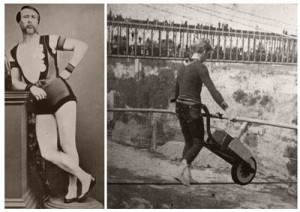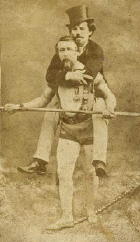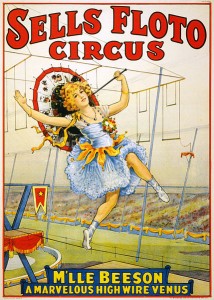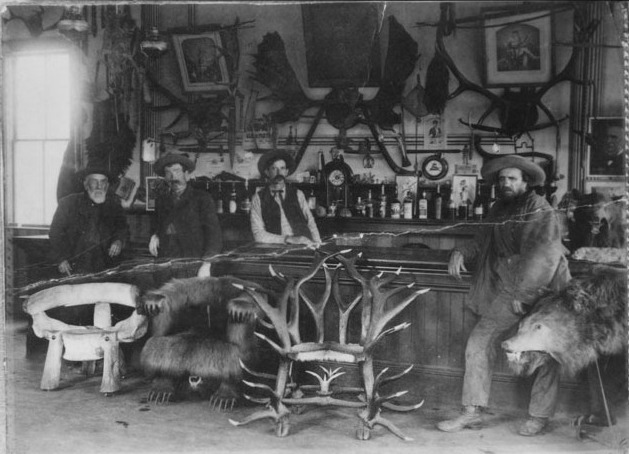Disco fabulous.
You are currently browsing the archive for the Videos category.
A fun 1963 profile of writer Ray Bradbury, then 43, which was made during the early days of the Space Race. Things on display that are going or gone: crowded bookstores, typewriters, filing cabinets.
Tags: Ray Bradbury
Atari famously brought the video game craze into the home with consoles that played removable cartridges rather than having games built into the system, but it wasn’t the first company to offer such a setup. The Fairchild Channel F did it earlier and one of Fairchild’s chief engineers and inventors, Jerry Lawson, just passed away. An excerpt from a new article about him on 1UP: “Engineer, inventor and video game pioneer Jerry Lawson passed away Saturday of unknown causes.
Lawson was among the earliest video game engineers. His first arcade title, Chicago Coins’ Demolition Derby, was developed in his garage in the early 1970s.
Lawson is remembered as the inventor of Fairchild Semiconductor’s home video game console, the Channel F. Released in 1976, the Channel F is the first console with programmable game cartridges; before it, home video game systems only played the games that were built into them.
Until recently, Lawson’s name was not very well known, even amongst the video game community. Fortunately, Lawson was honored by the International Game Developers Association’s Minority Special Interest Group at the Game Developers Conference just last month.”
Tags: Jerry Lawson
“My art is cultural, it represents the diminishing humanity in today’s society.”
Tags: Liu Bolin
An early instructional video about the Internet that was aimed at dreadful children in striped sweaters. (Thanks Reddit.)
At the recent BarBot 2011 event in San Fran. Still not as good as monkey waiters wearing lady masks. (Thanks Singularity Hub.)
Tags: Andy Kaufman, Freddie Blassie

"He walked across a rope stretched at a height of 120 feet, and was nearly knocked off during a performance by a man who shot fireworks at him."
The Great Blondin was the best of all 19th-century tightrope walkers, but there were plenty of others who attempted to master the art. This quintet of stories from the Brooklyn Daily Eagle relates some of the sublime and scary moments faced by high-wire practitioners.
••••••••••
“Blondin” (February 23, 1897): “A man who was as famous in his time as the Czar of all of the Russias has just died in a suburb of London at a comfortable age. He was Blondin, the rope walker. The man had many imitators and few rivals since he came into prominence, but none of them won quite the celebrity he enjoyed. Hardly any of them earned it, in fact. It was he who first conceived the notion of crossing Niagara on a tight rope at a great height above the rushing water, and this self appointed task he carried out, once wheeling a barrow, and again with his head enveloped in a blanket, again crossing at night and again carrying a man on his back. In the grounds of the Crystal Palace in London he walked across a rope stretched at a height of 120 feet, and was nearly knocked off during a performance by a man who shot fireworks at him. He returned to America not long ago and gave exhibitions at West Brighton that were seen by many thousands. Until he was 70 years old he retained his wonderful sense of balance and agility, and could be seen throwing handsprings in front of his house in Ealing.”
••••••••••

"It was he who first conceived the notion of crossing Niagara on a tight rope...carrying a man on his back."
“Cycling on a Live Wire” (July 30, 1897): “A decided novelty in the line of tight rope performances may be witnessed free at Ridgewood Park next week. Professor Arion, who attracted considerable attention several years ago walking on a narrow span over Niagara Falls, and who has since been giving exhibitions in various parts of the country, will ride a bicycle over a live trolley wire every afternoon and evening. The feat is the latest addition to Professor Arion’s repertoire. His wheel, with the exception of the tires, is a regulation bicycle, fitted up with thirty regulation globes, which receive a current of electricity from the trolley wire beneath. The suit which the performer wears is studded with similar lights, covered wires being attached to his clothing, and when riding at a height of 75 feet above the ground, the sight is a brilliant one. In addition to the above number of tricks, Professor Arion will make up a bed on the wire, first unrolling a mattress, then covering himself with sheets and blankets.”
••••••••••
“An Insane Tight Rope Walker” (April 22, 1884): “Harry Leslie who made himself famous by crossing the Niagara Falls on a tight rope, is in a violent state of insanity. He was arrested at nine o’clock last evening by an officer of the Seventh Precinct for attempting to stab a man. His mania is said to be grief at the death of his wife which occurred some time ago, and his failure to obtain steady employment. Last evening he created a sensation at his residence, corner Monserole and Manhattan avenues, Greenpoint, by throwing a rope from an upper window and announcing his intention of walking across the street. After thinking he had fastened it to the opposite house, a crowd of about 250 persons gathered below. While the rope was dangling from the window he clutched it and climbed on the sill, from which perilous position he was rescued with difficulty.
Leslie thinks he is a wealthy man and buys blocks of property in Greenpoint for which he gives worthless checks for millions. After the occurrence of last night he was watched by a member of his family. He attempted to stab the policeman who arrested him.”
••••••••••

"A piece of burning stuff from one of the lighted torches had fallen on her head and set her long hair on fire."
“An Exciting Scene” (January 30, 1869): “An exciting scene occurred the other day at Alcazer, in Spain. Mlle. Rose Saqui, a rope dancer, was performing some jugglery feats, balancing daggers, lighted torches, etc., on the tight rope, when suddenly the cry, ‘You’re on fire’ arose from the audience. A piece of burning stuff from one of the lighted torches had fallen on her head and set her long hair on fire. With one foot on the iron rope and another in the air, the woman did not lose her presence of mind. She passed her hand over her clothes and felt nothing. ‘In your hair!’ cried the excited people. Mlle. Saqui understood, and carried her hand to her head rapidly stifled the fire. She then continued her performance as if nothing happened.”
••••••••••
“The Advocates of Women’s Rights” (July 12, 1876): “The advocates of women’s rights ought to rejoice over the fact that a woman has successfully imitated the opposite sex in one other and hitherto untried field. An Italian woman walked over Niagara Falls on a tight rope and returned, on Saturday last. She performed the feat admirably well, and proposes to repeat it, the next time carrying a man on her back. That will not be hard to do as many of her sex can attest who have, figuratively speaking, carried some worthless member of the race over all the hard places in life. If there is a man so contemptible as to be willing to be thus publicly carried on a woman’s back, his entire brotherhood who permit women this privilege in the literal sense ought to rise up against him and exterminate him. Meanwhile, let the strong minded rejoice. If they have had not any new discovery or exceptional work accomplished by their representatives as yet, they have some clever imitators among the sex, and the most recently famous of the number is this young woman who has successfully crossed Niagara Falls.”
••••••••••
Tags: Charles Blondin, Harry Leslie, Mlle. Rose Saqui, Professor Arion

"On Aug. 16, 1987, thousands of new age adherents following the lead of Arguelles." (Image by Luke Hancock.)
On August 18, 1987, people gathered in Central Park (and other locales all over the world) for an odd event called Harmonic Convergence, blowing conch shells and dancing, which would supposedly delay Earth’s doom. It was a bit of ridiculousness birthed (with sincerity) by a Minnesota art historian named Jose Arguelles, who just passed away. Here’s an excerpt from his obituary:
“Jose Arguelles, an art historian whose teachings about the Mayan calendar inspired the harmonic convergence event of 1987, has died at age 72.
His publisher and a statement from his foundation said he died March 23, in Australia. A spokeswoman for the publisher said Monday the cause was peritonitis.
On Aug. 16, 1987, thousands of new age adherents following the lead of Arguelles gathered at places such as the red rocks of Sedona, Ariz., Serpent Mound in Ohio and the Arthurian town of Glastonbury in England.
Arguelles was living in Boulder, Colo., and had written The Mayan Factor: Path Beyond Technology, which argued for replacing the Gregorian calendar, said Earth was in the last phases of a galactic beam of light it entered in 3113 B.C., and called for meditation to give humanity a chance to enter a new age in 2012.
At a mountain campsite, he blew a conch shell, and around the world others chanted, formed circles, held hands at dawn and danced in what one participant said was an attempt to change the worldwide consciousness. Debunkers ranged from academics to the Doonesbury comic strip.”
Tags: Jose Arguelles
Beatrice Wood came to art late but with gusto. (Thanks Documentarian.)
From Michael Kimmelman’s 1999 remembrance of Wood in the New York Times: “The time is summer 1917, the place, Coney Island. Beatrice Wood is seated on a fake ox while behind her, in an oxcart, against a painted backdrop, sit Marcel Duchamp and Francis Picabia. They have come from the roller coaster. ‘With Marcel’s arm around me,’ Wood recalled years later, ‘I would have gone on any ride into hell with the same heroic abandon as a Japanese lover standing on the rim of a volcano ready to take a suicide leap.’ In the photograph she looks more queasy than lovestruck, clutching her hat as if afraid it might still blow off.
Wood, who died this year a few days after her 105th birthday, flirtatious to the end, became a potter of luminescent talent, having taken up ceramics in her 40’s when she failed to find a teapot to match some plates she had bought in Holland. Her fame, which mostly came later in life, stemmed from a combination of her art, her longevity and her sheer verve.
When she was born, Cezanne was still a little-known painter and Grover Cleveland was President. When she died, she was, in a sense, just coming into her own, having had a full-scale museum retrospective in New York City a year earlier and having been named a ‘living treasure’ by the Governor of California a couple of years before that. Through a friend she’d lately been introduced to a film director who decided to base a character in a new movie on her. The director was James Cameron. The character was Rose in Titanic.“
Tags: Beatrice Wood, Francis Picabia, James Cameron, Marcel Duchamp
I would guess that Hell’s Angels: A Strange and Terrible Saga is the most factual book that Hunter S. Thompson ever wrote. It’s amusing to see Gonzo look so intimidated, but, you know, you buy the ticket, you take the ride. (Thanks Documentarian.)
“The Angels don’t like to be called losers, but they have learned to live with it. ‘Yeah, I guess I am,’ said one. ‘But you’re looking at one loser who’s going to make a hell of a scene on the way out.'”
Tags: Hunter S. Thompson
Named “one of the greatest men of 2001” by the Polish edition of Elle.
Tags: Kuba Ka
“Cavity Sam” gets cracked open by a bot. (Thanks Singularity Hub.)
At Cornell University. (Thanks Open Culture.)
Tags: Richard Feynman
“He’s dead, man.”
As women joined the workforce in droves during WWII, this jaw-dropping educational video was there to prepare bosses to handle these strange creatures. Oy vey. (Thanks Reddit.)
I already posted a story about the rugged nineteenth-century hunter and chair maker Seth Kinman. The classic 1889 photograph above is a look at the eccentric interior of his bar in Table Bluff, California, which filled with whiskey many a Humboldt County sawmill employee.
••••••••••
Seth Kinman’s great great grandchildren display some of his memorabilia.
Tags: Seth Kinman
Even during WWII, they didn’t know such horror.
Impressive bots if not great soccer players. (Thanks IEEE Spectrum.)
Banal and endless. Like a Warhol version of the Youtube kitty video.
Senior stoners. (Thanks Live Leak.)
A week before the earthquake. (Thanks Reddit.)
Not really necessary to understand Spanish. (Thanks Reddit.)
Which was held in Italy. (Thanks Singularity Hub.)
Tags: Ray Kurzweil
A five-minute writing lesson from Kurt Vonnegut, the Mark Twain of our lifetimes. So it goes. (Thanks Open Culture.)
A 1970 Vonnegut commencement address, as covered by Time magazine:
“Like his novels, Kurt Vonnegut Jr.’s message to the graduating class of Bennington College was by turns desolately winsome, merely bleak and utterly but almost gaily despondent. Confessing to congenital pessimism, Vonnegut told the graduates: ‘Everything is going to become unimaginably worse and never get better again.’
Still, Vonnegut had some suggestions: ‘We would be a lot safer if the Government would take its money out of science and put it into astrology and the reading of palms. I used to think that science would save us. But only in superstition is there hope. I beg you to believe in the most ridiculous superstition of all: that humanity is at the center of the universe, the fulfiller or the frustrater of the grandest dreams of God Almighty. If you can believe that and make others believe it, human beings might stop treating each other like garbage.’
Vonnegut also asked the graduates to take advantage of some of youth’s prerogatives. A ‘great swindle of our time,’ he said, ‘is that people your age are supposed to save the world. I was a graduation speaker at a little preparatory school for girls on Cape Cod a couple of weeks ago. I told the girls that they were much too young to save the world and that after they got their diplomas, they should go swimming and sailing and walking, and just fool around.'”
Tags: Kurt Vonnegut


